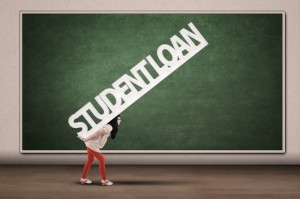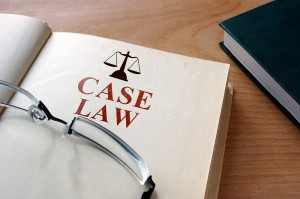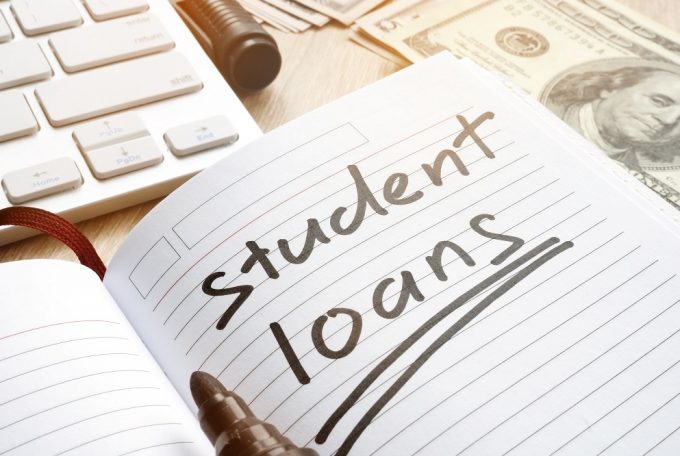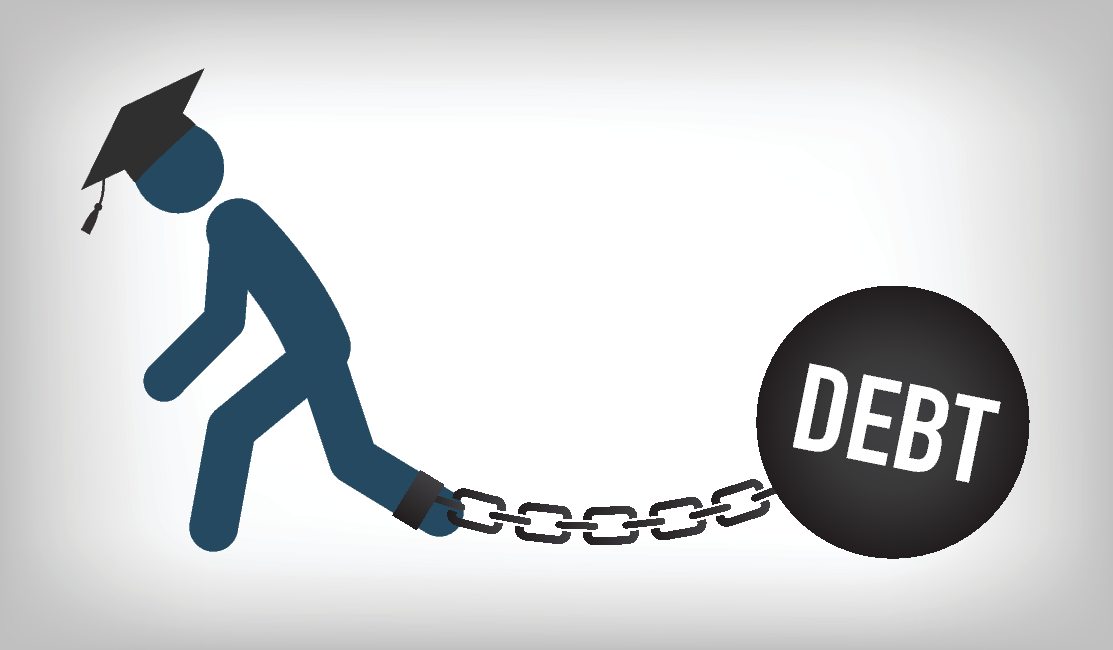Introduction to Student Loans and Bankruptcy
 Student loan debt in America is at an all-time high – it has even started to surpass the current amount of credit card debt, which is a first for this country.[i] With that being said, it is no surprise that many students are looking for options to get out of student loan debt faster rather than paying those loans for the next 25 years to life. For many people, making payments for even the next year is just not a viable option based on their current economic standpoint. While the general rule is that student loan debt are usually not dischargeable through a bankruptcy, Arizona has adopted a test to determine if a person can actually fall into an exception to this rule and discharge some or all of their student loan debt through their bankruptcy proceeding.[ii]
Student loan debt in America is at an all-time high – it has even started to surpass the current amount of credit card debt, which is a first for this country.[i] With that being said, it is no surprise that many students are looking for options to get out of student loan debt faster rather than paying those loans for the next 25 years to life. For many people, making payments for even the next year is just not a viable option based on their current economic standpoint. While the general rule is that student loan debt are usually not dischargeable through a bankruptcy, Arizona has adopted a test to determine if a person can actually fall into an exception to this rule and discharge some or all of their student loan debt through their bankruptcy proceeding.[ii]
The word “bankruptcy” to most people is often deemed to be a negative and overly complicated topic. There are a lot of common misconceptions about how bankruptcy actually works, and even more so about the fact that there are actually a few different routes an individual person can take through the bankruptcy process. Those routes include Chapter 7 bankruptcy and Chapter 13 bankruptcy. Chapter 11 bankruptcy can be an option for individuals, but it is not nearly as common as Chapter 7 and Chapter 13.[iii]
Process for Determining Whether Your Student Loans Can Be Discharged – The Brunner Test
Considering how high student debt is overall right now it is no wonder that many people are looking into bankruptcy options for their student loans. The process in which a debtor can look into discharging their student loans through bankruptcy not only has its own standards for the court to follow, there must also be a separate hearing that must be held to make that determination. This proceeding is called the adversarial proceeding.[iv] The adversarial proceeding is not exclusive to student loan proceedings, it can be used with a lot of different cases within the bankruptcy proceeding.[v] The proceeding is actually a lawsuit that is filed within the bankruptcy case.[vi]The proceeding will generally have its own separate case number, and even possibly a different attorney but whatever the case may be, it will still remain within the greater bankruptcy case overall.
 Now, during this adversarial proceeding the court will use what is called the Brunner Test to determine whether or not the student loans are eligible to be dischargeable through the bankruptcy proceeding. The first part of the Brunner Test is the debtor must show that the debtor is basically living in poverty.[vii] This means that the debtor would be unable to maintain the standard of living for themselves and their dependents, even with a nominal student loan payment.[viii] The standard of living the court is assessing is considered far below middle class. The court will expect you to live without a lot of the luxuries that more money could provide, such as iPhones and possibly even multiple cars unless necessary for that particular family. If you are living with multiple expensive smartphones and other extra luxuries in your life, the court is going to certainly inquire why you can pay for those items and not your other obligations: student loans. The court will expect you to maximize your income and reduce your expenses as much as possible.[ix]
Now, during this adversarial proceeding the court will use what is called the Brunner Test to determine whether or not the student loans are eligible to be dischargeable through the bankruptcy proceeding. The first part of the Brunner Test is the debtor must show that the debtor is basically living in poverty.[vii] This means that the debtor would be unable to maintain the standard of living for themselves and their dependents, even with a nominal student loan payment.[viii] The standard of living the court is assessing is considered far below middle class. The court will expect you to live without a lot of the luxuries that more money could provide, such as iPhones and possibly even multiple cars unless necessary for that particular family. If you are living with multiple expensive smartphones and other extra luxuries in your life, the court is going to certainly inquire why you can pay for those items and not your other obligations: student loans. The court will expect you to maximize your income and reduce your expenses as much as possible.[ix]
The next factor the court is going to consider for the Brunner Test is persistence. The court will look at whether this situation that the debtor is in will continue into the future without likely changing in the future.[x] If the debtor is unable to make the minimum payments for their student loans now and that will not change even in the next ten years, the court is more likely to determine that their financial situation is persistent. Some of the factors that the court has considered in previous cases include: has the debtor reached the maximum income level available in her field, does the debtor live in a rural area where there is no realistic possibility of increasing income, has the debtor lived frugally, has the debtor done everything possible to minimize expenses, and does the debtor have a kid with special needs.[xi] This list of factors is not an exhaustive list. The court can use these factors and many other factors to make their decision. Each case has a unique set of financial information for the court to determine, so the judge is likely to pick and choose certain factors for one debtor that they may not use for another debtor.
Now, if the debtor is likely to get a raise at work as a young professional or any number of other situations that show promise of financial increase in the future, the court is unlikely to find that their situation will remain unchanged financially. Overall, if the court finds that the current financial situation of the debtor is not going to change in the foreseeable future – then the court will find the debtors financial situation is persistent.
The final factor the court is going to look at is the good faith effort of the debtor.[xii] This is really as simple as it sounds – did the debtor make a good faith effort to pay their student loans? For instance, did the debtor shop around for a better paying job, or try to work with the student loan provider to set up a better financial arrangement. If the debtor has an excess of unnecessary bills, a $1,000 a month phone bill or $1,000 cable bill – the court may ask why those expenses were not cut down in lei of the student loan payments. Even though it is a societal norm today to have an expensive iPhone and cable or satellite television, there are cheaper options for both phones and television as well as many other luxury items. On the other hand, if the debtor is living incredibly cheaply with minimum luxury items, and is still unable to pay their student loans, the court is more likely to find that the debtor has made a good faith effort to pay those loans and just cannot do so.
If All Factors of the Brunner Test Have Been Met
Now, if the adversarial proceeding judge determines that the debtor has met each factor for the Brunner Test, then the judge can hold that all or part of the student loans can be discharged through the overall bankruptcy proceeding. Keep in mind that just because the adversarial proceeding judge determined that the student loans are dischargeable that is not an automatic decision that they WILL BE discharged. The debtor still has to now go through their primary bankruptcy proceeding and have the court accept their petition for bankruptcy. Many times the overall bankruptcy proceeding will have a separate judge who will have their own separate opinions on the matter and it will be up to that judge to make the final determination. During the overall bankruptcy proceeding the judge will review the petition for bankruptcy and make and overall finding, which after a successful adversarial proceeding, will include the student loans. In Arizona, and many western states, the court can decide to discharge all or just some of your student loans.[xiii] For more information see the article from Forbes on why it is so difficult to discharge student loan debt in bankruptcy.
Conclusion to Student Loans and Bankruptcy
Even though the adversarial proceeding can take place within a Chapter 7 bankruptcy or a Chapter 13 bankruptcy proceeding, it is more common with Chapter 7 bankruptcy. With Chapter 7 bankruptcy, the debtor will essentially liquidate as much of his valuable assets so he can make payments to each creditor to the fullest amount he can, after which the amounts remaining will be discharged. On the other hand, with a Chapter 13 bankruptcy the debtor continues to make payments to creditors for the next 3-5 years on a repayment plan that is created for the debtor.[xiv] Chapter 13 bankruptcy is a good backup plan for a Chapter 7 bankruptcy because it allows the debtor to have a few years of relief through reduced payments during that 3-5 year period.[xv] Each type of bankruptcy has its benefits and each debtor will have to choose which is best for them, but either way, student loans can be included in either type of bankruptcy.
 Recently an interesting case came out of the 7th Circuit Court of Appeals.[xvi] The case began in 2012 and discusses Mark Tetzlaff, a 57-year-old man with more than $260,000 in student loans from business and law school debt.[xvii] Tetzlaff filed bankruptcy with the court after repeatedly failing the bar exam post-graduation from Florida Coastal School of Law. Tetzlaff filed a Chapter 7 bankruptcy and sough to have the court determine that his loans were dischargeable. Tetzlaff based his argument for why the court should find his loans were dischargeable because he suffered from alcoholism, depression, and a criminal conviction that has barred him from many employment opportunities. He is currently living in Wisconsin with his mother, and the two of them live off of her social security income.[xviii]
Recently an interesting case came out of the 7th Circuit Court of Appeals.[xvi] The case began in 2012 and discusses Mark Tetzlaff, a 57-year-old man with more than $260,000 in student loans from business and law school debt.[xvii] Tetzlaff filed bankruptcy with the court after repeatedly failing the bar exam post-graduation from Florida Coastal School of Law. Tetzlaff filed a Chapter 7 bankruptcy and sough to have the court determine that his loans were dischargeable. Tetzlaff based his argument for why the court should find his loans were dischargeable because he suffered from alcoholism, depression, and a criminal conviction that has barred him from many employment opportunities. He is currently living in Wisconsin with his mother, and the two of them live off of her social security income.[xviii]
In the case, the 7th Circuit Court of Appeals has struggled with applying the undue hardship, or what is called the Brunner Test in Arizona. The Supreme Court of the United States has declined to review this case, which leaves the circuit courts to determine proper application of the undue burden test independent of the Supreme Courts influence.[xix] The 7th Circuit Court of Appeals did make the determination that Tetzlaff’s student loans would NOT qualify to become dischargeable because Tetzlaff failed to meet all three factors of the under hardship test. Remember that under the undue hardship test, the debtor must make a good faith effort to pay his loans. Here, Tetzlaff has failed to make any attempts at payments for a number of years.[xx] This test is already difficult to establish and when the debtor does not qualify for one of the factors right off the bat – then the likelihood that the court will determine the debtors loans are dischargeable are slim to none.[xxi] There are many variations of undue hardship test, and it is important that each debtor look into what standards their state looks for and applies in bankruptcy proceedings.[xxii]Bankruptcy tends to be the last financial resort available for many people but because of the negative ramifications to your credit score, many people try to avoid bankruptcy if possible. However, sometimes there are no other alternatives to bankruptcy. It is possible for any person may have to decide to go through with the process. With the help of skilled attorneys, the bankruptcy proceeding can be a smooth process for an individual – which is especially helpful during such a hard financial time. The fact that many states have begun to determine if student loans will qualify as dischargeable debt is a turning point in the law that will hopefully benefit those in need in the future.
[i] See Student Loan Debt Attorney (March 25, 2016). http://www.adllawaz.com/student-loan-debt-attorney/
[ii] Id.
[iii] See What is Chapter 11 Bankruptcy. Bankruptcy Law. (March 23, 2016). http://bankruptcy-law.freeadvice.com/bankruptcy-law/bankruptcy-law/eleventh_chapter.htm
[iv] See Adversary Proceedings in Bankruptcy (March 31, 2016). http://www.nolo.com/legal-encyclopedia/adversary-proceedings-bankruptcy.html
[v] Id.
[vi] Id.
[vii] See Discharging Student Loans in Bankruptcy: The Western States (March 25, 2016). http://www.nolo.com/legal-encyclopedia/discharging-student-loans-bankruptcy-the-western-states.html
[viii] Id.
[ix] Id.
[x] Id.
[xi] Id.
[xii] Id.
[xiii] Id.
[xiv] See Arizona Chapter 13 Bankruptcy Information. Arizona Bankruptcy Law. (March 20, 2016). http://www.arizonabankruptcylaw.com/chapter13.html
[xv] See Discharging Student Loans in Bankruptcy: The Western States (March 25, 2016). http://www.nolo.com/legal-encyclopedia/discharging-student-loans-bankruptcy-the-western-states.html
[xvii] Id. http://www.abajournal.com/news/article/would_be_lawyer_wont_have_260k_in_student_loans_erased_scotus_refuses_to_he
[xviii]Id.
[xix] Id.
[xx]Id.
[xxi] Id.
[xxii] Id.





